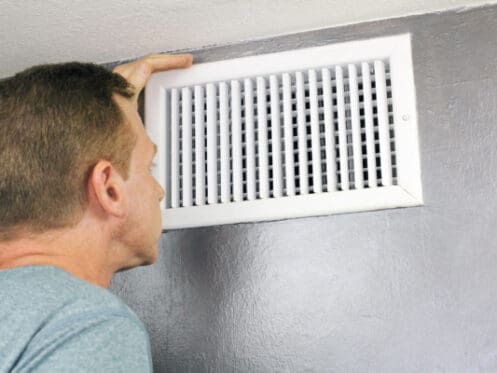Having clean, fresh air in your home is essential for the health and well-being of you and your family. Indoor air pollution can come from various sources, such as dust mites, mold, pet dander, volatile organic compounds (VOCs), bacteria, and viruses. In the long run, poor indoor air quality can cause various illnesses and allergies, ranging from headaches to asthma. Fortunately, improving indoor air quality is relatively simple but requires dedication and effort. Below are some tips to ensure your family breathes fresh air and enjoys a healthy living environment.
1. Regularly Clean and Dust the Home
A straightforward way to improve indoor air quality is by regularly cleaning and dusting your home. Dust mites, pet dander, pollen, mold spores, and other pollutants can easily accumulate on the surfaces of carpets, furniture, and windowsills. These pollutants are often invisible to the human eye.
Therefore, it’s essential to frequently vacuum and dust every corner of the house using a microfiber cloth and vacuum cleaner with a HEPA filter. Additionally, natural cleaning products such as vinegar and baking soda should be used instead of chemical-based ones since they do not release harmful VOCs into the air.
2. Improve Ventilation
Poor ventilation can worsen indoor air quality; ensuring air circulates and exchanges throughout the house is essential. Ventilation can be improved by regularly opening windows, using fans, or installing a whole-house ventilation system. Although it might sound obvious, this is the cheapest and easiest way to keep indoor air fresh.
Most homeowners find it easier to seal all openings, especially during winter, to conserve all the energy inside. This, however, contributes to poor quality air in their space. It is wise to open windows for a few minutes every day, even in winter, to allow fresh air to flow in and dust to flow out. Additionally, investing in bathroom exhaust fans to help remove humidity and pollutants caused by showering and bathing.
3. Install Air Filters/Purifiers
Air filters play a crucial role in the home’s air quality by trapping particles such as dust, pollen, and pet dander. Various air filters are available on the market with different sizes and technologies; some use electrostatic technology to capture particles from the air, while others use HEPA filters to capture airborne bacteria and viruses. Installing one or more air filters in your home can significantly improve indoor air quality.
4. Remove Contaminants With HEPA Vacuums
HEPA vacuum cleaners can improve indoor air quality by removing accumulated pollutants from inside the house. A high-quality HEPA filter helps remove small particles, allergens, bacteria, dust mites, mold spores, and other contaminants from surfaces. Additionally, a bagless vacuum cleaner should be emptied after every use to avoid recirculating dust particles in the air.
5. Control Moisture Levels
High humidity levels can worsen indoor air quality by causing mold growth and dust mites. Therefore, keeping moisture levels below 50% with a dehumidifier is recommended, especially during summer. Regularly checking water pipes for leaks and drying wet spots quickly can also help reduce humidity and improve indoor air quality.
6. Reduce Volatile Organic Compounds (VOCs)
Common indoor pollutants are volatile organic compounds (VOCs) such as benzene, formaldehyde, and styrene. These compounds come from various sources including paint fumes, household cleaning products, and furniture.
Avoid buying products containing VOCs. Use natural alternatives wherever possible to remove VOCs from the indoor air. Additionally, good ventilation is recommended when painting or using cleaning products, and open windows should be used to allow chemicals to escape outside.
7. Do Not Smoke Indoors
Indoor smoking releases toxins into the air including carbon monoxide and formaldehyde. This can significantly worsen air quality in the house and increase health risks for everyone inside. Therefore, it’s important not to smoke inside your home; if you choose to smoke, ensure you do it far away from the house.
8. Monitor Indoor Pollutant Levels Regularly
Regularly checking indoor pollutant levels is important in improving your home’s air quality. Various devices and tests are available to detect pollutants such as formaldehyde, carbon monoxide, and radon gas. Additionally, testing for mold growth can help identify the areas of the house with higher humidity levels.
9. Introduce Indoor Plants
Plants help purify the air by filtering out certain pollutants and releasing oxygen. Adding a few plants to your home can help improve indoor air quality, particularly if you have pets. Popular varieties such as ferns, spider plants, aloe vera, and English ivy are all known for their air-purifying capabilities. Such plants should be placed in areas with good ventilation and away from direct sunlight. Additionally, they contribute to a healthy decor aesthetic, making your home more pleasant.
10. Opt for Air-Purifying Wallpapers
Modern wallpapers come with air-purifying features. These products are made with materials such as plant extracts that can absorb pollutants like formaldehyde and other volatile organic compounds. Additionally, some special formulations contain photocatalytic properties that break down VOCs and other pollutants using light energy. Wallpapers with such features often come at a higher cost but are worth the investment in the long run.
11. Dry Out Damp Spots
If you notice any damp spots in your home, try to dry them out immediately. Dampness can lead to mold growth and worsen air quality, so addressing this issue as soon as possible is important. Also, make sure you also deal with the cause of the dampness; this could mean fixing a leaking pipe or replacing a damaged roof tile.
12. Say No to Air Freshners
Although air fresheners can make your home smell nice, they don’t do anything to improve air quality. They mask bad odors with a synthetic scent and can contain hazardous chemicals like formaldehyde and phthalates. To avoid such compounds, try using essential oils for natural fragrances instead.
13. Adopt Non-Toxic Paint
When renovating your home, opt for non-toxic paint and water-based products. Such paints come with low volatile organic compounds (VOCs) and release fewer toxins into the air. Natural finishes like milk paint are also available in the market and can help maintain good indoor air quality.
Contact the Experts
Clean air adds to your home’s comfort and living quality. With good air quality, you can rest assured that your home is free from pollutants and toxins. Following these 13 easy steps can help you to improve your home’s air quality today.
At First Choice Plumbing, Heating & Air Conditioning, we understand the importance of air quality in your home and can help you make the necessary changes to improve it. With years of experience dedicated to serving residents of Metuchen, NJ, and surrounding areas, our expert team can assess your home and advise on the best products and practices to improve your home’s indoor air quality. We also offer installation and maintenance services for your HVAC system. Plumbing services are available as well. These services include piping, drain cleaning, appliance installation, water treatments, and garbage disposal installation and repair.
Contact First Choice Plumbing, Heating & Air Conditioning today to schedule an appointment and get started on your journey to better air quality.



